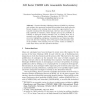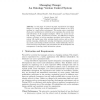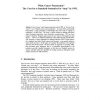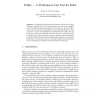OWLED
2008
14 years 5 months ago
2008
The OWLlink interface provides an implementation-neutral mechanism for accessing OWL reasoner functionality. In contrast to its DL-oriented predecessor DIG, OWLlink relies on OWL 2...
OWLED
2008
14 years 5 months ago
2008
We describe the architecture of a novel ontology and rule editor ACE View. The goal of ACE View is to simplify viewing and editing expressive and syntactically complex OWL/SWRL kno...
OWLED
2008
14 years 5 months ago
2008
OWLED
2008
14 years 5 months ago
2008
OWLED
2008
14 years 5 months ago
2008
Chemical Entities of Biological Interest (ChEBI) is a database and ontology that represents biochemical knowledge about small molecules. Recent changes to the ontology have created...
OWLED
2008
14 years 5 months ago
2008
Central to a coherent understanding of cellular biology is a faithful representation of biochemical processes as it pertains to its molecular participants. Current representations ...
OWLED
2008
14 years 5 months ago
2008
In this paper we present the basic requirements and initial design of a system which manages and facilitates changes to an OWL ontology in a multi-editor environment. This system u...
OWLED
2008
14 years 5 months ago
2008
One of the most salient tasks in law is legal assessment, and concerns the problem of determining whether some case is allowed or disallowed given an appropriate body of legal norm...
OWLED
2008
14 years 5 months ago
2008
: One of users' most frequent questions about OWL is "how do I say `may'?", as in "Bacteria may cause pneumonia." In many fields, particularly biomedi...
OWLED
2008
14 years 5 months ago
2008
Predicting the performance of a tableau reasoner for an OWL ontology is generally hard. It is even harder for users who are not familiar with the details of tableau algorithms. In ...




